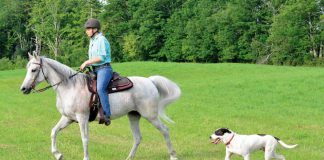When you head to the barn to saddle up, the last thing you’re thinking about is an accident or injury. Yet by its very nature, horseback riding has a potential for danger, and when a rider is injured, it’s important to know what to do, as well as what NOT to do.

“Falling from a horse can cause head, neck and back injuries, and injuries can be made worse if someone inexperienced tries to move the person, so just let them lie still until help arrives. You should also leave the rider’s helmet on,” explains Miranda Iglesias, public information officer for Marion Country Fire Rescue in Ocala, Florida.
When paramedics arrive, they will thoroughly evaluate rider and assess his/her condition. In addition to the rider’s story about what happened, the emergency responders will also want to hear from witnesses who saw how the rider fell. If a serious injury is obvious or suspected, the rider will likely be immobilized on a “spine board” prior to transport to a hospital or trauma center.
“Every fall from a horse can have a serious outcome. Even if the rider gets right back up after a fall and feels fine, we still recommend seeking medical attention from your doctor,” adds Iglesias. “Adrenaline can mask injuries that aren’t immediately apparent. Sometimes there can be bleeding in the brain or other internal injuries that are not always immediately apparent. Even if you feel okay you can still call 911; it’s always a good idea to document an accident.”
What to do immediately after a fall:
- Call 911.
- If the rider is injured, keep him/her still until help arrives.
- Check for pulse.
- Make sure rider is breathing/clear airway if necessary.
- Administer CPR if rider is unconscious.
- If a wound is bleeding, apply pressure with clean towel or T-shirt.
- Catch horse (if loose).
- If rider is a minor, notify parent or guardian.
What NOT to do after a fall:
- Don’t try to move the rider – this can increase risk of paralysis if there is a spinal injury.
- Don’t remove helmet
- Don’t ignore “minor” injuries that don’t require emergency attention; get evaluated to avoid long term effects of a fall.
Any of the following signs and symptoms can signal a head injury or concussion. Seek prompt medical attention:
- Loss of consciousness, even for a few seconds
- Headache
- Confused, dazed, or disoriented
- Dizziness
- Nausea or vomiting
- Loss of balance
- Blurred vision
- Ringing in the ears
- Trouble remembering or concentrating
- Sensitivity to light or sound
- Sudden mood change
- Depression or anxiety
- Change in sleep pattern (trouble sleeping or sleeping more than normal)
With hot weather just around the corner, riders should also be aware of heat stroke. Avoid physical exertion during hot, humid times of day and if you’re going to be outside working or riding, be sure to stay hydrated with water and sports drinks to replace electrolytes. Wear light-colored, loose fitting clothing and a hat that shades your face and shoulders.
Heat stroke is a form of “hyperthermia,” and takes place when the body’s temperature is dramatically elevated. It generally occurs during extremely high heat and/or humidity and/or when someone is dehydrated or engages in physical exertion during hot weather. While heat cramps and heat exhaustion are less severe, heat stroke is an emergency and can be fatal if not addressed promptly and properly.
Be aware of the following, which can be signs of heat stroke:
- Elevated temperature
- Lack of perspiration with flushed dry skin, or hot red skin
- Rapid pulse
- Trouble breathing
- Confusion, feeling disoriented
- Hallucinations
- Agitation
- Seizure
Permanent organ damage—or even death—can result if heat stroke victims aren’t treated immediately. Call 911 and follow instructions. It’s critically important to get the person cooled off right away. Move him/her out of the sun, remove any restrictive clothing and apply cool water. If ice is available, put ice packs under the arms and in the groin area. Encourage sweating by fanning the victim with moving air. Continue to cool the person until the body temperature drops to 101 to 102 degrees Fahrenheit.
Further Reading
Horse and Rider First Aid Kits
Get Your Head Together
Trail Riding Injuries






CPR should only be used if the rider is not breathing and/or does not have a pulse. Lack of consciousness does not require an additional person to fill the lungs or pump the heart.
CPR should never be administered except in the case of the individual having no pulse.
If a rider has fallen off a horse approaching a jump and can not move left leg and is numb. What should a medic do upon arrival ?